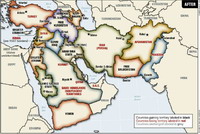Login form
Middle East
 The Middle East is not a country. It’s not a continent. It has no set borders. What is it then? What is it in the middle of?
The Middle East is not a country. It’s not a continent. It has no set borders. What is it then? What is it in the middle of?
WHERE IS THE MIDDLE EAST?
The heart of the Middle East stretches from Egypt in northeastern Africa to the countries of southwestern Asia. People disagree over exactly which countries make up the Middle East. Some scholars use a broader cultural definition. They believe the Middle East also includes all of the Muslim countries of northern Africa, as well as Afghanistan and Pakistan.
The term Middle East was coined in 1902 by a traveler from America. He meant the lands east of Europe but west of India and China. In truth, the heart of the Middle East is easier to locate than its edges.
WHO LIVES THERE?
Most of the people in the Middle East are Arabs. Other groups include the Persians of Iran, the Turks of Turkey, the Jews of Israel, and the Kurds. Most Kurds live in Turkey, Iran, and Iraq. The main language is Arabic. The languages of Farsi, Turkish, Hebrew, and Kurdish are also spoken.
More than 90 percent of the people in the Middle East are Muslims, who follow the religion of Islam. Yet the Jewish state of Israel is located at the heart of the Middle East. Small communities of Christians live there, too.
CRADLE OF CIVILIZATION
Three great rivers run through the Middle East: The Nile, Tigris, and Euphrates. The world’s first great civilizations started along the banks of these rivers.
The Nile River Valley in northeastern Africa gave birth to ancient Egypt about 5,000 years ago. About the same time, a center of civilization grew up on the fertile plain between the Tigris and Euphrates rivers in Mesopotamia (what is now Iraq). Here, people invented the wheel, the plow, a system of writing, and money.
BIRTHPLACE OF GREAT RELIGIONS
The Middle East contains some of the world’s most honored shrines. That’s because three major religions started here. They are Judaism, Christianity, and Islam.
Judaism started out as the religion of the Hebrew people. They built their first two temples in Jerusalem, now the capital of Israel. Christianity began with Jesus Christ, who was born in Bethlehem, a city near Jerusalem. The prophet Muhammad, the founder of Islam, was born in Mecca. Millions of Muslim pilgrims visit this city in Saudi Arabia every year.
HEART OF EMPIRES
A number of great empires have ruled the Middle East over the centuries. By 30 bc, Romans had advanced into the Middle East. Under Roman rule, Christianity became a major religion in the Middle East.
After the birth of Islam in the ad 600s, Muslim Arabs conquered much of the Middle East. Later, the Ottoman Turks ruled a powerful empire that included the Arab lands of the Middle East. Ottoman rule lasted from the 1500s to the early 20th century.
CONFLICT IN THE MIDDLE EAST
As Ottoman rule in the Middle East weakened, foreign powers tried to gain control of the region. After World War I (1914-1918), most of the Middle East was divided into territories controlled by France and Britain.
Arabs of the Middle East resented European control. Struggles for independence broke out. During the 1930s and 1940s, many territories of the Middle East gained their independence. Many of the new Arab leaders hoped to unite the Middle East and remove European influence from the region.
ARABS AND ISRAELIS
For decades, Israel and its Arab neighbors have been in conflict. Most Arabs have never fully accepted Israel, which was formed in 1948. Many Palestinian Arabs who once lived in Israel fled. They became refugees in the surrounding Arab countries. The conflict has led to several wars, the first one in 1948.
Since 1979, a series of peace accords have been signed that address some parts of the conflict. But negotiations have failed to bring the conflict to an end.
Source: Microsoft ® Encarta

